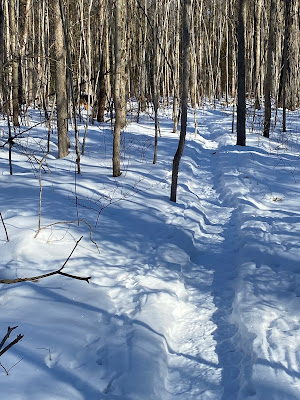Last January I published a blog post I called Exploring Awe in Art and Life. I wrote about travelling to Tofino, BC where I taught a Workshops in Wild Places class. While exploring the area, we met an incredible 1000-year-old red cedar tree. This year with Covid-19 and not being able to travel, experiences of awe are different. Instead of standing next to giant red cedar trees in the British Columbia rainforest or looking out over the moody Scottish landscape with its broad, inspiring vistas or watching powerful icebergs float down Iceberg Alley in Newfoundland, I look for awe much closer to home, in more ordinary places, like the forest behind my home.
In my current zoom workshop, Workshops in Wild Places Stays Home, I talked to the artists about having the intention to find awe in the land each time they go outside. If we look for the experience of awe, of course we find it. It's what I try to do. Sometimes of course, I am deep in thought as I enter the forest, or I'm pondering a problem or a worry and see nothing but the small track I have created over the years with my footsteps. But if I hold the intention of seeing awe, the same walk becomes a magical experience. I come away from the forest filled with gratitude. My heart feels larger.
As mythologist Joseph Campbell once remarked "awe is what moves us forward." He cited awe as a primary driver in the creation of mythology: the overwhelming sensation that you're part of something grand.
A new study published on September 21, 2020 in the journal Emotion, found that "a regular dose of awe reduces your stress and boosts your mental health. In the study, 60 older adults took weekly 15 minute awe walks for eight weeks. Half of the participants was randomly assigned to a simple walk group. The other half was placed in an awe walk group, in which researchers described the emotion of awe and suggested the walkers try to experience that emotion as they strolled. Answers to open-ended survey questions reflected awe walk participants' growing sense of wonder and appreciation for the details of the world around them. In contrast, participants from the control group tended to be more inwardly focused. The researchers also asked participants to take selfies at the beginning, middle and end of each walk". What I found really interesting was that "analysis of these photos revealed a parallel, visible shift in how participants portrayed themselves. The awe group increasingly made themselves smaller in their photos over the course of the study, preferring to feature the landscapes around them".
"One of the key features of awe is that it promotes what we call 'small self', a healthy dose of proportion between your own self and the bigger picture of the world around you," explained Dr. Virginia Sturm, lead investigator from the University of California. “Negative emotions, particularly loneliness, have well-documented negative effects on the health of older adults, particularly those over age 75." She goes on to say, “What we show here is that a very simple intervention – essentially a reminder to occasionally shift our energy and attention outward instead of inward – can lead to significant improvements in emotional well-being.”
This morning after I read this article, I sat down near my wood stove to join my online meditation group. I looked out the windows onto the snowy forest. Amazingly I saw 2 red foxes walk past, not 20 ft. from my windows. What a gift! I often see fox tracks but rarely a fox. And I've never seen 2 together. When we turn outward, open ourselves up and become receptive vessels, the world gives us gifts.
 |
| The second red fox walking through the woods behind my house. I wasn't ready when the first fox passed by! |
"I've been referred to as odd before. Nowadays, I prefer to refer to myself as 'awed'. I want awe to be the greatest ongoing relationship in my life. I want to move through my days floored by the magnificence and generosity of my Creator. The breaking of a day, the silence between words, the light emanating from a real conversation, and kindness, truth, love and the apparently random hand of grace: I want to remain gobsmacked by all of it. Rendered speechless by wonder, I await the next unfolding. Peace, friends. Be awed today." Richard Wagamese from the book Embers: One Ojibway's Meditations




Good Morning Janice. Thank you what a wonderful blog on inviting awe to be present in or everyday daily. Awe- I think it’s the difference between moving through life and being with Life
ReplyDelete